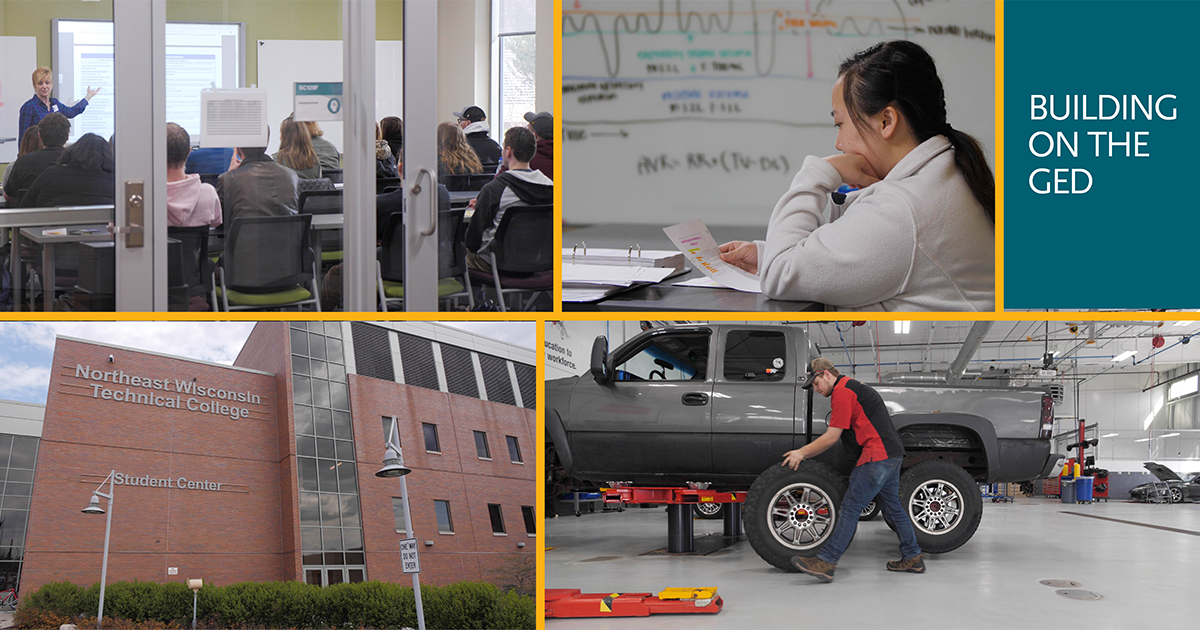Building on the GED
Promising Results from a Bridge-to-College Model

 Bridge-to-college programs aim to help people complete high school and enroll in postsecondary education, two milestones that increase access to economic opportunity. These programs help students obtain their high school credentials while encouraging postsecondary transition and success.
Bridge-to-college programs aim to help people complete high school and enroll in postsecondary education, two milestones that increase access to economic opportunity. These programs help students obtain their high school credentials while encouraging postsecondary transition and success.
Northeast Wisconsin Technical College (NWTC) in Green Bay, Wisconsin, implemented a bridge-to-college program in 2015 to help more students earn their GED credentials and transition to postsecondary education. This GED Bridge program had three components that distinguished it from NWTC’s traditional GED class, called GED Prep 2: (1) a NWTC-developed “contextualized” curriculum — one that focused on original texts and materials related to specific careers (to build students’ academic skills and raise their awareness of those careers) — in contrast to GED Prep 2 classes that focused on GED test preparation materials; (2) individual support to help students plan their transition to postsecondary education, plus career exploration and transition planning in class; and (3) managed cohort enrollment, meaning that students started each class section together, in contrast to the open enrollment of the GED Prep 2 class where new students could enroll at any time.
This report describes an evaluation of NWTC’s GED Bridge program that included impact, implementation, and cost analyses. The impact analysis employed a random assignment design. Eligible applicants were randomly assigned to either the GED Bridge class or the GED Prep 2 class and followed for 18 months. The research team used administrative data to measure differences in class attendance and persistence, GED testing and completion, and enrollment in postsecondary education.
Key Findings
- Students in the GED Bridge classes generally received the contextualized curriculum, managed cohort enrollment, and enhanced planning and support for transition to postsecondary education. These experiences differed from those of students in the traditional GED Prep classes, though they differed to varying degrees from semester to semester.
- Students assigned to the GED Bridge program had significantly higher rates of GED class attendance and attended those classes over a longer period.
- GED Bridge group students were more likely to earn GEDs and enroll in college courses. GED Bridge increased the percentage of students who earned GEDs by 11.7 percentage points and increased enrollment into college courses by 8.5 percentage points.
- As implemented at NWTC, the GED Bridge program was more expensive than GED Prep 2 and was not as cost-effective (meaning it did not result in a lower cost per GED credential earned). Its higher costs were in part a result of how NWTC staffed the GED programs and enrolled students, which resulted in more experienced teachers in GED Bridge classes and smaller student-teacher ratios. Students in GED Bridge also stayed in the program longer and received transition support not available to GED Prep 2 students, which increased costs.
This evaluation contributes to a small but growing body of research that suggests that bridge-to-college programs may be effective in improving both GED completion and postsecondary enrollment.







